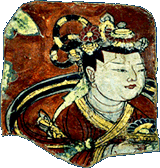Among the thousands of faces painted in the Buddhist cave temples of western China, there are some distinctly un-Chinese features. One fragment shows a nobleman holding a flower. Although he is drawn in the style of Chinese Buddhist art (an iconography derived from northern India) there is something unusual about him. He has a full black beard. Another fresco shows a swarthy figure with topknot and worry beads. Neither man is Chinese; both are Turks – in the eyes of the smooth-skinned Han Chinese, barbarians.
But barbarians they were not. For these people are Uighurs, leaders of a Turkic tribe which emerged in the eighth century from the scrum of nomads along China’s northern border to create an empire rivalling the Tang dynasty of China.
Their princes, or khans, made capital and court at Karabalghasun on the River Orkhon in present-day Mongolia. Like the Chinese emperor, who had to call on these ‘barbarians’ twice to save his throne, they believed in their divine appointment. They took Chinese princesses as wives and charged exorbitant prices in silk, grain and tea for their horses (a trade the Chinese tried to disguise as ‘tribute’).
Originating in Mongolia and Siberia, the Turks had begun to mobilise in the sixth century, long before the Uighur ascendancy. In 568, for example, a Turkic ambassador had been dispatched to Constantinople. By 744 their rule reached from Mongolia to the Caspian. For most of the next thousand years they were to dominate not only Central Asia and Xinjiang (formerly known as Chinese Turkestan) but also the Caucasus and Anatolia.
The name ‘Turk’ came to stand for unity and a common language: variants of Turkish are still spoken from the Balkans to Yakutia (present-day Siberia). These early Turks were sky-worship-pers who consulted shamans and magic pebbles. The Uighur kings converted to Manichaeism, the ‘religion of light’, imported by refugees from the Middle East. In 840, perhaps too used to easy living, they were driven out to settle in their former lands of Xinjiang and Gansu, with a new capital, Kucha, near Turfan in western China.
Kucha became a cultural and religious powerhouse, as the German archaeologist Albert von Le Coq found when he excavated the city and the nearby Bezeklik cave shrines in 1904. Some of his trophies will be in the exhibition. Here the Uighurs converted to Buddhism, devoting themselves to riding and archery. Many carried musical instruments everywhere they went; the Uighurs are still reputedly the finest musicians in Central Asia.
A rich literary inheritance was established for them by Mahmud al-Kashghari, the eleventh-century Turkic poet and scholar. By his time, the Uighurs had abandoned their quasi-runic script of 38 characters, which was not deciphered until the late nineteenth century, for a modified Sogdian script of seventeen letters, derived from Iranian. This they bequeathed to Genghis Khan and his invading Mongols, their ethnic cousins, for whom they acted as administrators. With the arrival of Islam from the West, Arabic script prevailed.
The Uighur khanate in eastern Xinjiang survived until the 1930s. ‘Uighur’ is a generic name for all the Turkish Muslim people of Xinjiang, whether descended from the Uighurs of Turfan or not. Still essentially Turkic, their language and way of life are now under threat.
Reference
Christian Tyler. This feature first appeared in RA Magazine as ‘Dynastic Visions’. For more Turks features visit www.ramagazine.org.uk



